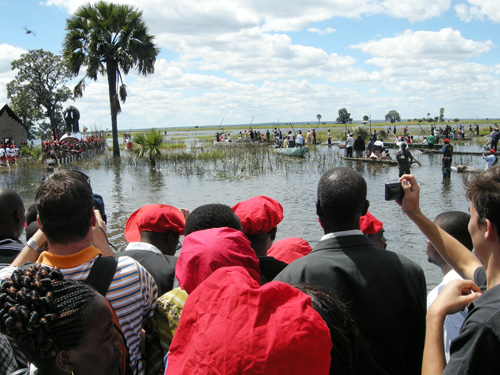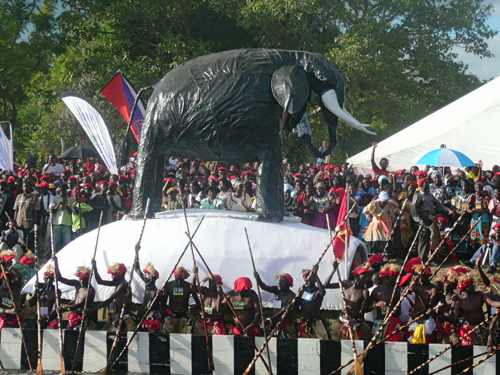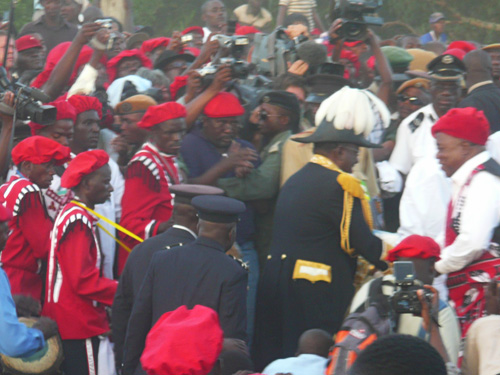Photography and photostory production by Valerie Duffy.
Background
Each year in Zambia’s Western Province the Litunga – the King/Paramount Chief of the Malozi people, moves in a symbolic ceremony known as the Kuomboka (“get out of water”).
This ancient ceremony celebrates the move of the Litunga from his ‘summer’ home at Lealui in the flooded villages of the Barotse Floodplain, to his ‘winter’ home in Limulunga on the higher ground, until the flooded plains subside in June/July. The festive event is celebrated each year at the end of the rainy season (around March/April) when the upper Zambezi River floods the plains of Western Province. The Litunga decides the date for the ceremony a few weeks beforehand after considering the level of the floods, the availability of food and the phase of the moon.
The Litunga is accompanied on the journey by his Prime Minister and other local area chiefs known as the Indunas. The Litunga’s boat/barge is named “Nalikwanda” and is large enough to carry his possessions, his attendants, his musicians, his 100 paddlers, and has a large statue of an elephant – the Lozi symbol of power. The boat is painted with black and white stripes and it is considered a great honour to be one of the paddlers on the Nalikwanda.
The ceremony begins with two white scout canoes that are sent to check the depth of the water and for the presence of any enemies. Once the scouts signal the ‘all clear’, the journey to the highland begins. The Litunga’s royal boat is followed by another boat for his wife and another for the Prime Minister. The journey to Limulunga normally takes about 6-8 hours. Drums beat throughout to coordinate and energise those paddling the barge.
The Litunga begins the day in traditional dress, but during the journey changes into the full uniform of a British admiral that was presented to the Litunga in 1902 by King Edward VII, in recognition of treaties signed between the Lozi people and Queen Victoria. The ceremony is attended by hundreds of people each year.
The Kuomboka Ceremony 2009
Day 1: Thursday, April 9th
At 21:00, the Maoma Royal drums are beaten at Lealui to summon paddlers for the Kuomboka Ceremony. This is a special occasion as the Maoma are first beaten by His Majesty, Litunga Lubosi Imwiko II (Mbumu wa Maoma) and then members of the Royal Family led by Natamoyo, Indunas, and the general public take turns to sound the Royal drums. The Maoma are beaten non stop until about 23:00. It is said that on a quiet night, the sound of Maoma can be heard up to 15 kilometres away.
Day 2: Friday, April 10th
Hundreds of people descend on Lealui, including paddlers from various parts of Barotseland. The Royal Canoeing Regatta takes place on this day where the competition is flagged off by His Majesty, the Litunga.
Day 3: Saturday, April 11th – Kuomboka Day!!
At 07:00 the Mutango, the first and oldest Royal drum, is played at Limbetelo, sending the message that the Litunga of Barotseland is set for the journey to Limulunga. At Mongu harbour, people gather to travel by various boats to Lealui through the flooded Barotse plain.
At approximately 09:30, His Majesty the Litunga, dressed in traditional Silozi kilt (sikutingo), leaves the Palace and, in keeping in tune with the Royal drums, walks majestically to Lealui Nayuma Harbour. Eulogists, the praise chanters, with very strong voices take turns in praising the Litunga.
The Litunga boards the Nalikwanda Royal Barge, usually paddled by up to 120 men. The Nalikwanda sets off followed by Notila, Matende, Mbolyanga, Sabelele, Nalikena (for the Ngambela) and hundreds of small boats and canoes.
At 16:00 the spy boats Natamikwa and Mundende arrive before Nalikwanda docks at Limulunga Harbour where the Litunga is received by thousands of people. A display of Manjabila, Lishoma, and Maoma, are played before the Nalikwanda docks. Men perform the Silozi Royal salute (kushowelela) while the women dance and sing limeka and liimba. The Litunga emerges from the Nalikwanda immaculately dressed in his Royal Admiral Ceremonial suit in tune with Royal drums. He walks majestically (Kutamboka) to the Royal Pavilion (Lutatai). Paddlers, like warriors, dance to Lishoma and then perform the Silozi Royal salute.
At 21:00, the Maoma Royal drums are beaten to announce that his Majesty Litunga Lubosi Imwiko II is now in the winter capital, “Limulunga lya mulonga lya mambo kupula”.
Day 4: Sunday, April 12th
At 05:00, the Maoma Royal Drums are beaten following the same procedure till 07:00. The Maoma Royal drums will not be sounded again till Kufuluhela Ceremony, when his Majesty, the Litunga, returns to Lealui. This is followed by Silozi Royal salute (kushowelela) by the Ngambela (Prime Minister), Indunas, and paddlers.
A variety of traditional songs and dances are performed.
Ngommalume Royal dance performed at the Palace Square (Namoo), is the major activity of the day after Maoma. Ngomalume means men’s dance. It is a warrior’s dance after a victorious conquest. Men wear animal skins (lipatelo) or traditional kilts (liziba) and red berets (mashushu). These skilful dancers entertain the Litunga and thousands of visitors, tourists, and the general public. Ngomalume ends with Nalikanda and Lishoma.
In the evening, women prepare for liwale dance (kushunela liwale) in the palace yard.
Day 5: Monday, April 13th
Liwale Royal dance is the major dance of the day. It is performed by women led by princesses. All women wear flamboyant traditional Silozi dress known as misisi. They dance to the rhythm of the Royal drums without a song. This dance ends with the Silenga and Lishoma dances.
Day 6: Tuesday, April 14th
The major traditional dances are siyemboka and lilombola performed by the subjects of both Mwene Chiyengele and Mwene Kandala of Nanoko and Mabumbu respectively. These are performed in front of the Litunga.










